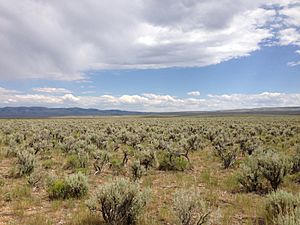Sagebrush steppe facts for kids
The sagebrush steppe is a special type of natural area found in the western United States. It's like a big, open grassland, but instead of just grass, it's covered mostly by a plant called sagebrush. Sagebrush is a type of shrub, which is a small, bushy plant. This unique ecosystem is found in places like the Great Basin and Colorado Plateau. It is home to many different animals and plants.
Contents
What is Sagebrush Steppe?
A sagebrush steppe is a kind of "shrub-steppe." This means it's a plant community where shrubs are common, and sagebrush is usually the main plant. Sagebrush belongs to a plant group called Artemisia.
The Sagebrush Plant
The most common type of sagebrush you'll find in these areas is called big sagebrush. Other kinds include three-tip sagebrush and low sagebrush. These sagebrush plants grow alongside many different types of grasses.
Home to Many Animals
The sagebrush steppe is a very diverse place, meaning it has many different kinds of living things. More than 350 types of animals with backbones (like mammals, birds, and reptiles) have been recorded here.
Important Animals of the Steppe
This habitat is very important for animals that are becoming rare. These include the greater sage-grouse, a large bird known for its unique mating dance, and the pygmy rabbit, which is one of the smallest rabbits in North America.
Why Sagebrush Steppe is Important
Besides being a home for wildlife, sagebrush steppe areas are used for other things too. They provide open land for livestock like cattle to graze. People also use these areas for fun activities like hiking and hunting. Plus, they are a source of water in dry regions.
Threats to the Sagebrush Steppe
Sadly, the sagebrush steppe is in danger in many places. It used to cover huge areas in the western United States. But now, it has been broken up and damaged by several problems.
Invasive Plants
One big problem is that plants from other parts of the world, called introduced species, have started to grow here. These new plants can take over. For example, some areas have changed from sagebrush steppe into forests with pine and juniper trees.
The Danger of Wildfires
These changes have also affected how fires naturally happen in the area. When new plants grow, they can create more fuel for fires. This increases the chance of very big and damaging wildfires. A plant called cheatgrass is a major introduced plant that makes fires much more likely and severe in this ecosystem.
Other Problems
Other things that hurt the sagebrush steppe include trying to stop all fires (called fire suppression), which can lead to more fuel building up. Also, too many livestock grazing in one area, known as overgrazing, can damage the land.
Consequences of Damage
When the sagebrush steppe is damaged, it causes several problems. The land can erode more easily, meaning soil washes away. This also leads to dirt and mud getting into local rivers and streams, which makes the water quality worse. There is less good food for livestock, and the habitat for wildlife and game birds gets worse.


